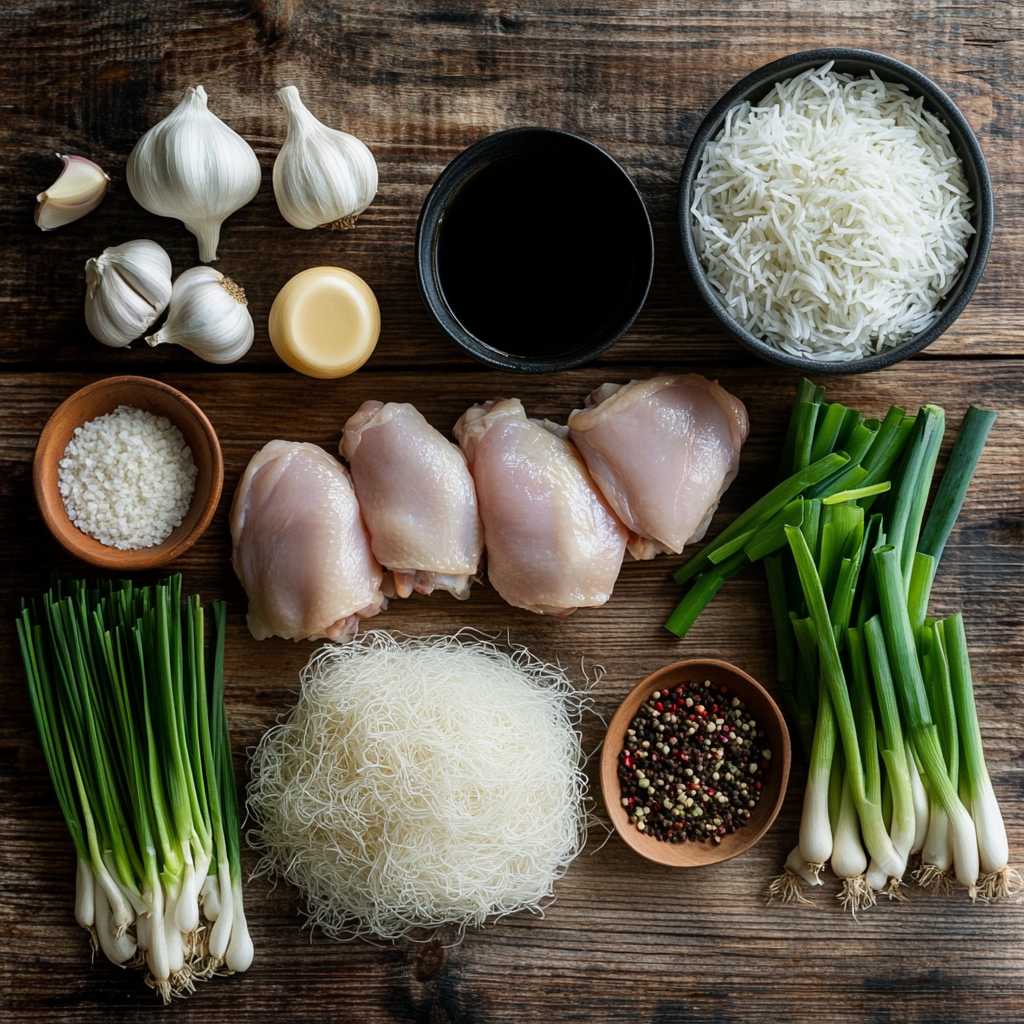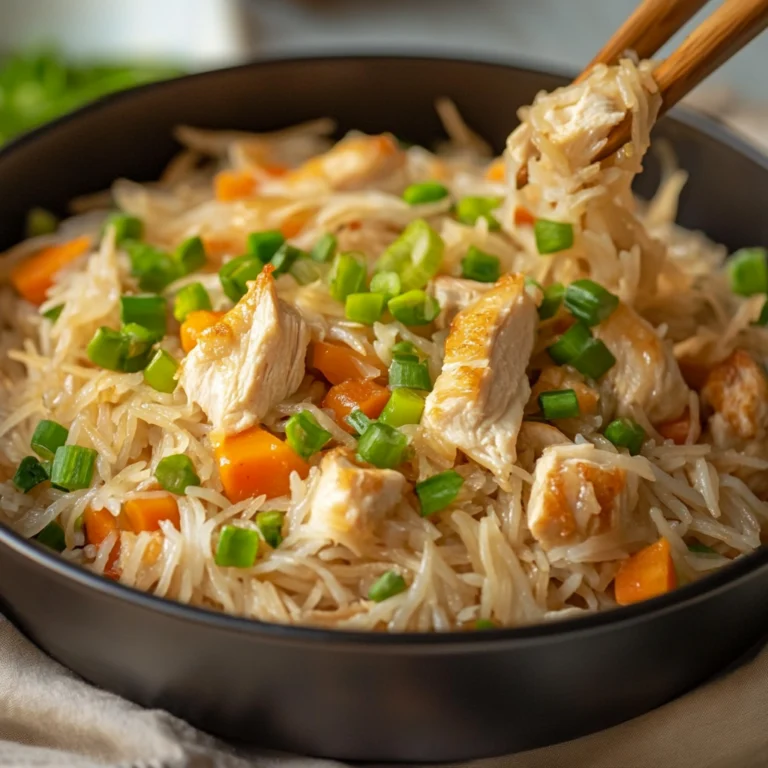Introduction
A Taste of Hawaii in Every Bite
Chicken Long Rice recipe is more than just a dish—it’s a culinary journey into Hawaii’s rich cultural heritage. Born from the blending of Chinese and Hawaiian influences, this recipe is a staple at luaus and cherished family dinners. Its warm, savory broth paired with tender chicken and delicate glass noodles offers a unique combination of comfort and flavor that speaks to the heart of island cuisine. Whether you’re longing for a tropical escape or simply craving a bowl of something hearty, Chicken Long Rice delivers every time.
Learn more about this dish’s origins and ingredients on Wikipedia.
Table of contents
Why Chicken Long Rice is a Luau Favorite
Often considered the “ultimate comfort food” of Hawaiian gatherings, Chicken Long Rice holds a special place on the buffet table. Its mild yet flavorful profile complements bold dishes like spicy chicken soup or Kalua Pork. Beyond its deliciousness, this dish is celebrated for its simplicity and versatility. It’s quick to prepare, easily customizable, and appeals to both adventurous eaters and those who enjoy more subtle flavors.
From its role as a soothing entrée to a dependable side dish, Chicken Long Rice is a true crowd-pleaser. And the best part? You don’t need to live in Hawaii to enjoy it. With just a handful of pantry staples and a little guidance, you can recreate this island favorite in your kitchen.
Essential Ingredients for Chicken Long Rice Recipe
Breaking Down the Key Ingredients
To achieve the authentic flavors of Chicken Long Rice recipe, each ingredient plays a vital role:

- Chicken Thighs: Opt for boneless, skinless chicken thighs for a tender, juicy texture. Their higher fat content adds depth to the broth, creating a rich base.
- Bean Thread Noodles: Also known as cellophane noodles or glass noodles, these are the hallmark of the dish. Their translucent appearance and chewy texture perfectly soak up the broth’s savory flavors.
- Chicken Broth: A good-quality chicken broth serves as the foundation. Homemade or store-bought, ensure it’s low-sodium to better control seasoning.
- Soy Sauce: This staple ingredient introduces a salty, umami punch that balances the dish. Light soy sauce works best to avoid overpowering the flavors.
- Garlic and Ginger: The dynamic duo of Asian cooking. Garlic brings warmth, while fresh ginger adds a hint of spice and freshness, elevating the broth’s complexity.
- Sugar: A small amount of sugar balances the soy sauce’s saltiness and enhances the dish’s natural flavors.
- Green Onions: For a pop of color and a mild oniony zest, these make an excellent garnish.
Where to Find Authentic Ingredients
Sourcing quality ingredients is key to mastering Chicken Long Rice:
- Bean Thread Noodles: Found in the Asian aisle of most supermarkets or in specialty Asian grocery stores. Look for brands that list mung beans as the primary ingredient for the best texture.
- Fresh Ginger and Garlic: These are readily available in most stores, but for a fresher taste, visit a local farmers’ market. Pre-minced options can be used in a pinch, but fresh is always preferable.
- Soy Sauce Options: Choose a naturally brewed soy sauce for a more authentic taste. Gluten-free versions are widely available if needed.
By selecting high-quality ingredients, you set the foundation for a flavorful and authentic Chicken Long Rice experience.
Looking for more hearty chicken recipes? Try this Chicken and Yellow Rice Recipe for another comforting classic.
Step-by-Step for Chicken Long Rice Recipe
Cooking Chicken Long Rice recipe is a straightforward process, but following the steps carefully ensures the best results. From creating a flavorful broth to mastering the perfect noodle texture, this guide will help you recreate this beloved Hawaiian dish with ease.
1. Prepare the Flavorful Broth
The broth is the heart of this dish, so taking time to layer flavors is key.
- Combine the Base Ingredients:
In a large pot, pour in 32 ounces (4 cups) of chicken broth. Add 3 tablespoons of soy sauce, 3 cloves of minced garlic, 2 tablespoons of freshly grated ginger, and 1 teaspoon of sugar. The garlic and ginger form the aromatic backbone, while the soy sauce brings umami richness. Stir everything together to ensure the sugar dissolves completely. - Bring to a Boil:
Set the pot over medium-high heat and let it come to a gentle boil. This step helps release the flavors of the garlic and ginger into the broth, creating a fragrant base for the dish. As the mixture heats, you’ll notice the comforting aroma that gives this dish its distinct appeal.
2. Cook the Chicken
Tender, shredded chicken is a hallmark of Chicken Long Rice recipe, and slow simmering ensures it stays moist and flavorful.
- Add the Chicken to the Broth:
Place 1 pound of boneless, skinless chicken thighs into the pot. Chicken thighs are preferred for their juiciness and flavor, but you can also use chicken breast if desired. Submerge the chicken fully in the broth to allow even cooking. - Simmer Gently:
Lower the heat to medium-low and let the chicken simmer for 30-40 minutes. The slow cooking process allows the chicken to absorb the savory and aromatic flavors of the broth. Avoid boiling, as it can make the chicken tough. - Check for Doneness:
After 30 minutes, check the chicken. It should be cooked through and tender, with an internal temperature of 165°F (74°C). Remove the chicken from the pot and set it aside to cool slightly. - Shred the Chicken:
Once cool enough to handle, use two forks to shred the chicken into bite-sized pieces. Shredding allows the chicken to integrate seamlessly with the noodles, making each bite flavorful and satisfying.
3. Prepare the Noodles
The translucent, springy noodles are what make Chicken Long Rice so unique. Proper preparation ensures they soak up the flavorful broth without becoming mushy.
- Soak the Noodles:
While the chicken is simmering, place 8 ounces of bean thread noodles (also known as cellophane or glass noodles) in a large bowl. Cover them with warm water and let them soak for about 15 minutes. This step softens the noodles, making them pliable and easier to cook. - Drain and Set Aside:
Once the noodles are softened, drain them thoroughly and set them aside. Avoid over-soaking, as the noodles will continue to absorb liquid once added to the broth.
4. Assemble the Dish
Now it’s time to bring all the elements together for a satisfying bowl of Chicken Long Rice.
- Skim the Broth:
Before returning the chicken to the pot, use a spoon to skim any excess fat or foam from the surface of the broth. This step ensures a clean, flavorful base. - Combine the Ingredients:
Add the shredded chicken back into the pot. Stir gently to distribute the chicken evenly throughout the broth. Next, add the drained noodles, ensuring they are fully submerged in the liquid. - Simmer Together:
Allow the noodles to simmer in the broth for about 5 minutes, or until they are fully cooked and have absorbed the flavors. Stir occasionally to prevent sticking. At this stage, the noodles should be soft but still have a pleasant chew.
5. Adjust and Serve
The final touches bring everything together and allow you to customize the dish to your liking.
- Taste and Adjust Seasoning:
Taste the broth and adjust as needed. If it tastes too mild, add a splash of soy sauce or a pinch of Hawaiian sea salt. For a richer flavor, consider adding a drop of sesame oil or a hint of fish sauce. - Add Garnishes:
Once satisfied with the flavor, ladle the Chicken Long Rice into bowls. Garnish with sliced green onions for a burst of color and a mild oniony zest. You can also sprinkle toasted sesame seeds or a dash of chili oil for extra flair.
Pro Tips for Perfection
- Control the Noodle Texture:
To avoid overcooking, add the noodles only during the final simmering stage. If you prefer firmer noodles, shorten the simmering time by a minute or two. - Soupier Consistency:
If you enjoy a brothier dish, feel free to add more chicken broth. Keep additional broth warm on the side and stir it in as needed. - Make It Ahead:
Chicken Long Rice tastes even better the next day, as the flavors have more time to meld. To reheat, warm gently on the stove with a splash of broth to prevent the noodles from absorbing all the liquid.
By following these detailed steps, you’ll master the art of making Chicken Long Rice, a dish that’s as comforting as it is flavorful. Whether you’re serving it for a family meal or a festive gathering, the results are sure to impress.en broth as needed.
For additional flavor variations, consider garnishing with toasted sesame seeds or chili oil. Find inspiration for side dishes in this guide on how to make the most of rotisserie chicken leftovers.
Tips to Customize Chicken Long Rice
Flavor Boosts
Enhancing the traditional recipe is easy with a few creative tweaks:
- Mushrooms: Add shiitake or button mushrooms to the broth for an earthy depth of flavor. Slice them thinly and let them simmer with the chicken for the best results.
- Vegetables: Incorporate bok choy, napa cabbage, or julienned carrots for added nutrition and crunch. Add these during the final 5-10 minutes of cooking to retain their texture.
- Spices: A splash of sesame oil or a pinch of red pepper flakes can introduce a subtle nutty or spicy kick. Experiment with star anise or a cinnamon stick for a hint of sweetness and warmth.
- Fish Sauce: A small splash of fish sauce can amplify the umami profile, especially if you’re using low-sodium chicken broth.
Dietary Adjustments
Adapting Chicken Long Rice to meet dietary needs ensures everyone can enjoy this classic dish:
- Gluten-Free Option: This recipe is naturally gluten-free if you use a gluten-free soy sauce. Double-check your broth and noodles to ensure compliance.
- Vegetarian/Vegan Version:
- Swap the chicken for tofu or mushrooms as a protein substitute.
- Use vegetable broth instead of chicken broth, and replace fish sauce (if used) with a vegan alternative or extra soy sauce.
- Low-Sodium Alternative: Opt for low-sodium soy sauce and chicken broth. Adjust the seasoning with a pinch of salt to control the overall sodium levels.
- Low-Carb Twist: Substitute bean thread noodles with zucchini noodles (zoodles) or shirataki noodles for a lower-carb version that still delivers on texture.
Customizable Serving Suggestions
Elevate the dish further by pairing it with traditional Hawaiian sides or fusion accompaniments:
- Serve with sticky white rice for a heartier meal.
- Pair with a side of kimchi or pickled vegetables for a tangy contrast.
- Garnish with fresh cilantro, fried shallots, or sesame seeds to add layers of flavor and texture.
These customization ideas allow you to tailor Chicken Long Rice to suit your taste preferences, dietary requirements, or the ingredients you have on hand.
Frequently Asked Questions
- What type of noodles are best for Chicken Long Rice?
Bean thread noodles (also known as cellophane or glass noodles) are traditional for this recipe. Their translucent texture and ability to absorb broth flavors make them ideal. - Can this dish be made ahead of time?
Yes! Chicken Long Rice can be prepared in advance. Store it in an airtight container in the refrigerator for up to 3 days. Reheat gently on the stove, adding a splash of chicken broth if needed to loosen the consistency. - How long does Chicken Long Rice keep in the fridge?
Properly stored in an airtight container, it will last for 3-4 days. Be sure to cool the dish completely before refrigerating to preserve freshness. - Can I use chicken breast instead of thighs?
Absolutely. While chicken thighs are more flavorful and tender, chicken breast works just as well. Adjust the cooking time slightly to avoid drying out the meat. - How do I prevent noodles from overcooking?
Soak the bean thread noodles just until pliable, and add them to the pot only during the final 5 minutes of cooking. Over-soaking or overcooking can make the noodles mushy. - What can I serve with Chicken Long Rice?
Pair it with Hawaiian staples like sticky rice, lomi lomi salmon, or a side of macaroni salad for a complete meal.
Conclusion
Chicken Long Rice is a delightful fusion of flavors, combining the savory richness of chicken and broth with the delicate chew of bean thread noodles. Its simplicity and versatility make it a dish that can be enjoyed year-round, whether as a comforting meal at home or a centerpiece at a festive gathering.
With this recipe, you’ll be able to recreate the magic of Hawaiian cuisine in your own kitchen. Experiment with the tips and variations to make it uniquely yours, and don’t forget to share your creation with friends and family—because, just like the dish itself, food is all about connection and aloha.

